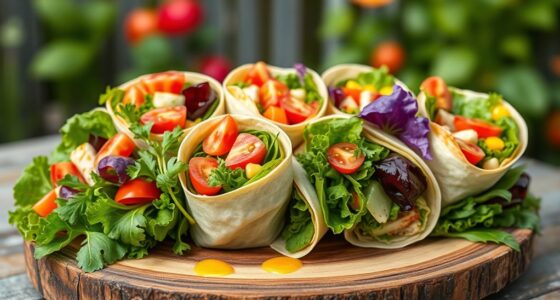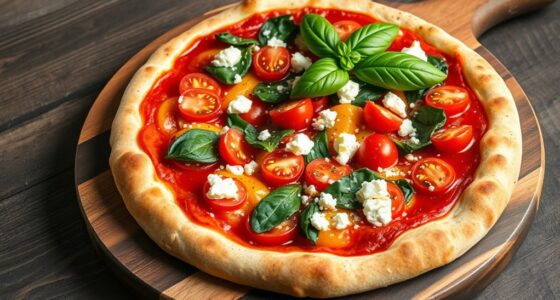To meal prep like a pro, choose containers that are microwave-safe, leak-proof, and made from eco-friendly materials like glass or BPA-free plastic. Organize your food with stackable or compartmentalized options, and label everything to reduce waste. Proper storage in the fridge or freezer keeps your meals fresh and safe. Using durable, high-quality containers guarantees longevity and safety. Keep these tips in mind, and you’ll master meal prep with confidence—more useful insights await as you explore further.
Key Takeaways
- Use microwave-safe, BPA-free containers to ensure food safety and prevent chemical leaching during reheating.
- Choose eco-friendly, durable materials like glass or bamboo to reduce environmental impact and enhance longevity.
- Incorporate leak-proof lids and stackable designs for organized, spill-proof storage and easy transport.
- Label containers with dates to track freshness and reduce food waste, optimizing meal prep efficiency.
- Opt for dishwasher-safe, high-quality containers to simplify cleaning and maintain their integrity over time.

Meal prep containers have become essential tools for anyone looking to save time, stay organized, and maintain a healthy diet. When choosing your containers, it’s important to consider microwave safety. You want to ensure that the materials used can withstand microwave heat without warping, melting, or releasing harmful chemicals. Look for containers labeled as microwave-safe, and always check for any manufacturer guidelines. This way, you can reheat your meals conveniently without worry, knowing the container won’t compromise your health or the food’s quality.
Choose microwave-safe meal prep containers to reheat meals safely without harmful chemicals or warping.
In addition to microwave safety, eco-friendly materials are gaining popularity among health-conscious and environmentally aware individuals. Opt for containers made from sustainable, biodegradable, or recycled materials. These eco-friendly options often include bamboo, glass, or certain types of BPA-free plastics that don’t leach chemicals into your food. Not only do they help reduce your environmental footprint, but they also tend to be more durable and safer for everyday use. Glass containers, in particular, are an excellent choice because they are microwave-safe, resistant to staining and odors, and free from plastics’ potential toxins.
Choosing the right containers also involves considering their design and functionality. For example, containers with secure, leak-proof lids prevent spills and keep your food fresh longer. Compartments or stackable designs help organize different meal components, making it easy to pack balanced meals for work, school, or travel. When shopping, pay attention to the material quality—thick walls and sturdy lids mean your containers will last longer and withstand daily wear and tear.
Proper storage is equally important for meal prep success. Use containers that fit well in your fridge, freezer, or lunch bag, maximizing space and making your meal prep routine more efficient. Labeling your containers can also help you keep track of expiration dates and prevent food waste. For added convenience, consider containers that are dishwasher safe, which simplifies cleanup and saves time.
Understanding the material quality and construction of your containers can also impact their longevity and safety. Ultimately, your choice of meal prep containers should reflect your priorities—whether that’s safety, sustainability, or convenience. Prioritize microwave-safe, eco-friendly materials to ensure your meals stay fresh, safe, and environmentally responsible. By selecting the right containers, you make your meal prep process smoother, healthier, and more eco-conscious. With the right tools, you’ll find it easier to stick to your dietary goals while minimizing your impact on the planet.
Frequently Asked Questions
How Long Can Meal Prep Containers Safely Store Food?
You can safely store food in meal prep containers for about 3 to 4 days in the fridge, depending on the type of food. To maximize container longevity and keep your meals fresh, follow proper storage tips like sealing containers tightly and labeling them with dates. Always check for signs of spoilage before eating. For longer storage, consider freezing, which can extend shelf life up to 3 months.
Are Glass Containers Microwave-Safe?
You might think all glass containers are microwave-safe, but that’s not always true. Many glass containers are durable and labeled microwave-safe, making them safe for reheating. Always check the container labeling to confirm. Glass is generally resistant to heat, but verify the lid is microwave-safe if you plan to use it. This helps prevent cracks or damage, ensuring your containers stay durable and your food stays safe.
What Are the Best Materials for Leak-Proof Containers?
You want the best leak-proof containers, so look for ones with strong leak-proof seals to prevent spills. Materials like high-quality BPA-free plastic and stainless steel are ideal because they offer excellent container durability, resisting cracks and dents over time. These options guarantee your food stays fresh and secure during transport. Choose containers with tight-fitting lids and durable construction to keep your meal prep leak-proof and reliable.
How Should I Clean and Sanitize Meal Prep Containers?
Picture your containers as sturdy shields guarding your meals; to keep them in top shape, wash them with warm, soapy water or run them through the dishwasher, ensuring they’re thoroughly cleaned. Use a gentle brush to scrub corners, and avoid harsh abrasives that could damage container durability. Don’t forget to remove container labels before cleaning to prevent residue buildup. Proper cleaning preserves your containers’ integrity and keeps your meal prep safe and fresh.
Can I Freeze Food in Plastic Containers Safely?
Yes, you can freeze food in plastic containers safely if you choose the right ones. Don’t fall for plastic container myths that all plastics are unsafe; look for BPA-free, freezer-safe labels. Follow freezer safety tips, like leaving space for expansion and cooling food first. Properly labeled, these containers prevent spills and preserve food quality, making your meal prep efficient and safe for longer storage.
Conclusion
By choosing the right containers, storing your meals properly, and following safety tips, you set yourself up for success. When you prep meals like a pro, you save time, reduce waste, and enjoy healthy eating all week long. It’s a simple rhythm—plan, store, and savor—that keeps your routine running smoothly. Trust the process, stay consistent, and you’ll see how effortless and rewarding meal prep can be. Keep it up, and enjoy the benefits every day.








